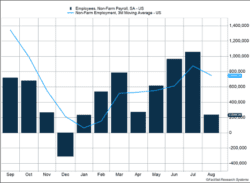The U.S. economy produced just 235,000 new jobs in August, missing expectations of 725,000. Unemployment dipped to 5.2%. Average hourly earnings rose 0.6%, partly because wages continue to rise more rapidly compared to the pre-pandemic pace.
Key Points for the Week
- U.S. job creation slowed last month as only 235,000 new jobs were created.
- Emergency unemployment benefits expired for 7.5 million people.
- Auto sales declined 10.7% in the face of chip shortages.
Enhanced unemployment benefits and programs targeting the self-employed expired on September 6. Approximately 3.3 million workers were receiving extended benefits, and 4.2 million gig and self-employed workers lost COVID-related benefits.
U.S. auto sales declined 10.7% compared to the previous month and are now 14.4% lower than last year. Chip shortages, plant shutdowns, and potential demand risk are also pressuring the industry.
Stocks took the jobs data and other challenges in stride. The S&P 500 gained 0.6%. The MSCI ACWI jumped 1.3%. The Bloomberg U.S. Aggregate Bond Index dipped 0.1%. August was an excellent month for stock investors. The S&P rose 3.0%, and global stocks added 2.5%. Bonds dipped slightly.
Figure 1
A Varied Report
The Details
The Delta variant is sapping momentum from the U.S. recovery. Nonfarm payrolls rose just 235,000, which was well below expectations for 725,000 jobs created. The unemployment rate fell from 5.4% to 5.2%. The big miss had a similar feel to the April report, when expectations were even higher and a similar number of jobs was created. [Figure 1]
Weak job creation in the service sector contributed to the sluggish report. The service sector only created 203,000 jobs, lagging each of the previous two months by more than 500,000 jobs. Restaurant hiring dropped sharply as the leisure and hospitality industry reported flat employment. Between April and July, leisure and hospitality accounted for 61% of the gains in private payrolls.
The goods sector performed much better. Manufacturing added 37,000 jobs, construction contracted by 6,000 jobs, and mining grew by 3,000 jobs. The net gain of 40,000 was in line with previous months. Increased hiring by auto manufacturers helped push manufacturing employment higher and may signal some improvement in the number of semiconductor chips available for vehicles.
The Delta variant affected other data as well. The percentage of remote workers ticked higher to 13.4%, the first increase since the COVID surge in the fourth quarter of 2020. Average hourly earnings rose 0.6% in August as businesses used higher wages to lure workers back to serve customers. Wages in the leisure and hospitality industry increased 0.7%.
The Big Picture
The U.S. economy needs to create about 150,000 jobs each month just to absorb new workers entering the labor force. That means an economy still bouncing back from COVID only employed a net 85,000 existing workers. Considering there are still 5.3 million fewer people employed than prior to the pandemic, getting only 1.6% of those workers rehired means the economy will take longer to heal if this trend continues.
Containing the Delta variant is the most important task to reigniting the jobs recovery. The Delta variant suppressed demand in certain places, but it also kept some potential workers outside the labor force.
Our expectation is hiring will pick up in coming months. Enhanced unemployment benefits have now expired. Some people will have greater incentive to take jobs, although we expect this effect to be gradual rather than immediate.
Underlying some of this data is a lower emphasis on work. Given the health risks in some positions, people may not view the higher wages as enough compensation for the risk. Labor force participation remained at 61.7%. Younger workers may be choosing to forgo part-time work to reduce health risks. Based on the prevalence of help-wanted signs at many fast-food restaurants, people who normally took these positions seem less interested. Whatever the reason, more hiring and willing workers are both necessary to return the economy to growth.
—
This newsletter was written and produced by CWM, LLC. Content in this material is for general information only and not intended to provide specific advice or recommendations for any individual. All performance referenced is historical and is no guarantee of future results. All indices are unmanaged and may not be invested into directly. The views stated in this letter are not necessarily the opinion of any other named entity and should not be construed directly or indirectly as an offer to buy or sell any securities mentioned herein. Due to volatility within the markets mentioned, opinions are subject to change without notice. Information is based on sources believed to be reliable; however, their accuracy or completeness cannot be guaranteed. Past performance does not guarantee future results.
S&P 500 INDEX
The Standard & Poor’s 500 Index is a capitalization-weighted index of 500 stocks designed to measure performance of the broad domestic economy through changes in the aggregate market value of 500 stocks representing all major industries.
MSCI ACWI INDEX
The MSCI ACWI captures large- and mid-cap representation across 23 developed markets (DM) and 23 emerging markets (EM) countries*. With 2,480 constituents, the index covers approximately 85% of the global investable equity opportunity set.
Bloomberg U.S. Aggregate Bond Index
The Bloomberg U.S. Aggregate Bond Index is an index of the U.S. investment-grade fixed-rate bond market, including both government and corporate bonds.
https://www.bls.gov/news.release/empsit.nr0.htm#
https://www.wsj.com/articles/BL-REB-35429
https://www.wsj.com/articles/weekly-jobless-claims-09-02-2021-11630527461?mod=newsviewer_click
Compliance Case # 01124613



